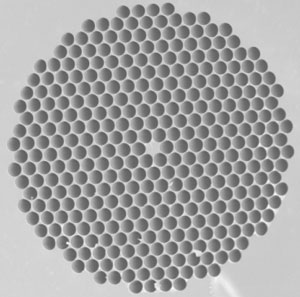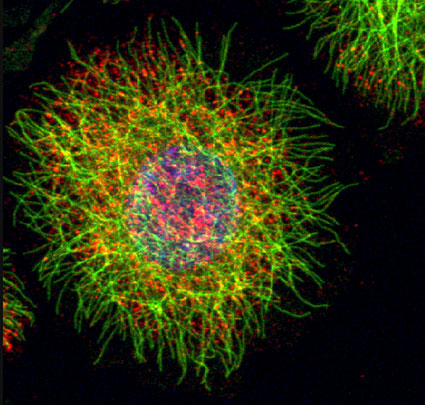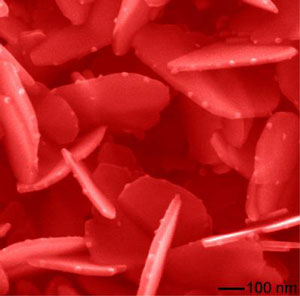University of Illinois chemists have developed a simple sensor to detect an explosive used in shoe bombs. It could lead to inexpensive, easy-to-use devices for luggage and passenger screening at airports and elsewhere.
Oct 19th, 2010
Read more
Twisting spires, concentric rings, and gracefully bending petals are a few of the new three-dimensional shapes that University of Michigan engineers can make from carbon nanotubes using a new manufacturing process.
Oct 19th, 2010
Read more
Some bacteria react to the cold by subtly changing the chemistry of their outer wall so that it remains pliable as temperatures drop. Scientists identified a key protein in this response mechanism a few years ago, but the question of how bacteria sense cold in the first place remained a mystery. Based on a new study, the answer is: They use a measuring stick.
Oct 19th, 2010
Read more
Forever linked by a single molecule - Nobel team reunites for Rice's Buckyball Discovery Conference
Oct 19th, 2010
Read more
In cold weather, many children can't resist breathing onto a window and writing in the condensation. Now imagine the window as an electronic device platform, the condensation as a special conductive gas, and the letters as lines of nanowires.
Oct 19th, 2010
Read more
The long-held dream of creating atomically precise three-dimensional structures in a manufacturing environment is approaching reality, according to the top scientist at a company making tools aimed at that ambitious goal.
Oct 19th, 2010
Read more
Georgia Tech researchers are prominently represented among the authors in the newly released Encyclopedia of Nanoscience and Society, published by SAGE Publications, Inc.
Oct 19th, 2010
Read more
Wissenschaftlern der Universitaet Aarhus ist es zusammen mit Mikrobiologen der Justus-Liebig-Universitaet Giessen gelungen, Palladium-Nanopartikel mit biologischer Unterstuetzung herzustellen.
Oct 19th, 2010
Read more
 The Universidad Politecnica de Madrid's Artificial Intelligence Group has created a new DNA-based biological sensor that has potential applications in the field of genetic diagnostics. The basic sensor design was presented at the 2010 Conference on Unconventional Computation.
The Universidad Politecnica de Madrid's Artificial Intelligence Group has created a new DNA-based biological sensor that has potential applications in the field of genetic diagnostics. The basic sensor design was presented at the 2010 Conference on Unconventional Computation.
Oct 19th, 2010
Read more
 Photonic crystals could usher in an age of low-power optical computing, but they're hard to manufacture. Maybe adding a little DNA would help.
Photonic crystals could usher in an age of low-power optical computing, but they're hard to manufacture. Maybe adding a little DNA would help.
Oct 19th, 2010
Read more
 Precise regulation of tissue architecture is critical for organ function. Single cells build up a tissue by communicating with their environment and with other cells, thereby receiving instructions on whether to divide, change shape or migrate. An interdisciplinary group of researchers from several Max Planck Institutes have now identified a mechanism by which skin cells organize their interior architecture as a response to signals from their surroundings.
Precise regulation of tissue architecture is critical for organ function. Single cells build up a tissue by communicating with their environment and with other cells, thereby receiving instructions on whether to divide, change shape or migrate. An interdisciplinary group of researchers from several Max Planck Institutes have now identified a mechanism by which skin cells organize their interior architecture as a response to signals from their surroundings.
Oct 19th, 2010
Read more
Forscher machen Bewegung magnetischer Monopole in einer Anordnung von Nanomagneten sichtbar.
Oct 19th, 2010
Read more
Different conducting polymers form a special class of materials with the potential for many applications in organic electronics and functional materials. These polymers can be electronically conducting or semiconducting due to a conjugated polymer backbone, or alternatively possess conductivity due to mobile protons or other ions. A new thesis discusses such conducting polymers and shows ways how they can be processed by printing and how the nanostructure allows controlling their electrical properties.
Oct 19th, 2010
Read more
 For the first time scientists have been able to watch nanoparticles grow from the earliest stages of their formation.
For the first time scientists have been able to watch nanoparticles grow from the earliest stages of their formation.
Oct 18th, 2010
Read more
Theoretical work done at the Department of Energy's Oak Ridge National Laboratory has provided a key to understanding an unexpected magnetism between two dissimilar materials.
Oct 18th, 2010
Read more
Researchers at the UC Riverside Bourns College of Engineering have built and successfully tested an amplifier made from graphene that could lead to more efficient circuits in electronic chips, such as those used in Bluetooth headsets and toll collection devices in cars.
Oct 18th, 2010
Read more





 Subscribe to our Nanotechnology News feed
Subscribe to our Nanotechnology News feed